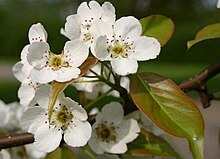Pyrus ussuriensis
| Ussurian pear | |
|---|---|

| |
| P. ussuriensis buds, leaves, and flowers | |
| Scientific classification | |
| Kingdom: | Plantae |
| Clade: | Tracheophytes |
| Clade: | Angiosperms |
| Clade: | Eudicots |
| Clade: | Rosids |
| Order: | Rosales |
| Family: | Rosaceae |
| Genus: | Pyrus |
| Species: | P. ussuriensis
|
| Binomial name | |
| Pyrus ussuriensis | |
Pyrus ussuriensis, also known as the Ussurian pear, Harbin pear, and Manchurian pear, is a species of flowering plant in the family Rosaceae.[1]
It is native to Korea, Japan, china, and the Ussuri River area of far eastern Russia. It has flowers in spring that are slightly pink when budding and then turn white.[2] Buds are dark brown and have an alternating arrangement. The tree grows to a height of about 15 meters (49 ft) and prefers well-drained loam-type soils. It is considered the hardiest of all pears.[3] When planted in milder climates, the trees have been known to be killed by freezes after they begin budding.[3] Many species of birds and mammals feed upon the fruit of this species. Deer, mice, and rabbits are known to damage the trees.[4] Leaves are dark green in spring and summer and turn dark red and gold in autumn.[2] Products made from the fruits may prove more effective than commercial insecticides in killing ticks and mites.[5] The fruits are not the tastiest of pears to humans, but the taste is better after a freeze and the juice tastes better. Crosses of this species with other pears produces tasty pears that grow in climates too cold for most pears.[3]
Cultivars include the 'Reli', 'Jinxiang', 'Hongbalixiang', 'Baibalixiang', 'Fuwuxiang', 'Qiuxiang', 'Fuanjianba', 'Longxiang', 'Guanhongxiao', 'Shanli24', 'Wuxiangli', 'Shatangli', 'Manyuanxiang', 'McDermand' , and the Prairie Gem® Flowering Pear (cultivar ‘MorDak’).[4] There are at least 108 compounds in the fruits that affect plant breeding and these show that P. ussuriensis cultivars fall into 4 groups.[6]
References
[edit]- ^ a b "Pyrus ussuriensis". Germplasm Resources Information Network. Agricultural Research Service, United States Department of Agriculture. Retrieved January 25, 2014.
- ^ a b "Pyrus ussuriensis" (PDF). Colac Otway Shire, Victoria, Australia. 2013. Archived from the original (PDF) on February 2, 2014. Retrieved January 25, 2014.
- ^ a b c "Pyrus ussuriensis - Ussurian Pear". Mustila Arboretum. Retrieved January 25, 2013.
- ^ a b "Ussurian or Harbin Pear" (PDF). North Dakota State University. Retrieved January 25, 2014.
- ^ Jeon, J. H.; Yang, J. Y.; Lee, H. S. (2012). "Acaricidal Activities of Materials Derived from Pyrus ussuriensis Fruits Against Stored Food Mites". Journal of Food Protection. 75 (7): 1258–1262. doi:10.4315/0362-028X.JFP-12-040. PMID 22980009.
- ^ Qin, Gaihua (2012). "Evaluation of the Volatile Profile of 33 Pyrus ussuriensis Cultivars by HS-SPME with GC–MS". Food Science. 134 (4): 2367–2382. doi:10.1016/j.foodchem.2012.04.053. PMID 23442698.
External links
[edit] Media related to Pyrus ussuriensis at Wikimedia Commons
Media related to Pyrus ussuriensis at Wikimedia Commons Data related to Pyrus ussuriensis at Wikispecies
Data related to Pyrus ussuriensis at Wikispecies- "Pyrus ussuriensis". Plants for a Future.
- Pyrus ussuriensis in the CalPhotos photo database, University of California, Berkeley

